Keeping tabs on the temperature of your CPU is very critical. You can prepare for a disaster beforehand and take measures to prevent your PC from shutting down suddenly.
While Windows users have some great tools, do not get disheartened if you are on Linux. I have compiled a list of tools that you can easily use to monitor your Linux computer’s temperature.
So, let’s not waste any more time and cut right to the chase.
How to Check the CPU Temperature in Linux
To monitor the CPU temperature on Linux, navigate to the system directory and open the files that contain the processor’s temperature. Or you can use tools such as Lm-Sensor and Psensor. Both will work from the terminal, and you can get the accurate temperature for your processor.
Let’s take a look at those.
These are the methods to check the CPU temperature in Linux:
1. Using the Linux System Files
The Sys directory contains files relating to the Linux kernel and all detected hardware on your computer. From there, you need to navigate to the thermal directory, which stores the CPUs temperature. If you navigate to sys/class/thermal folder, you can see the different zones where the temperature is recorded. Out of all these, we only want the ones recording the CPUs temperature.
There are data from two sensors in the directory. One is near the CPU (acpitz), and another one is inside the CPU (x86_pkg_tmp). Once we open the files, we can view the processor’s temperature.
Let’s take a look.
Here are the steps to check the CPU temperature using the Linux System Directory:
- Press Ctrl + Alt + T to open the terminal.
- Type in the following commands:
cat /sys/class/thermal/thermal_zone*/temp Here you can see the temperature in five digits. So a temperature of 56000 is basically 56 degrees.
But to view the temperature in a nice format, you can type in the following command. This basically pulls the recent CPU temperature and puts the value in a columnar format.
paste <(cat /sys/class/thermal/thermal_zone*/type) <(cat/sys/class/thermal/thermal_zone*/temp) | column -s $'\t' -t | sed 's/\(.\)..$/.\1°C/' Here you can see the temperatures from the respective zone listed. If you only see the temperature from one displayed, then that is your CPUs temps.
2. Using Lm Sensor
Lm Sensor can check your CPU’s temperature on Linux. As it is a command-line tool, you can install and monitor the temperatures entirely from the Terminal. The command to install the application differs based on which Linux distribution you use.
Here are the steps to install Lm Sensor in Linux:
- Press Ctrl + Alt + T to bring up the Terminal.
- Type sudo apt install lm-sensors (for Debian), and press Enter.
- Provide your admin password if prompted by the system.

During the installation, you will see files downloaded from the servers. You do not need to pay attention to this as these are just the progress made by the package manager. They look similar to this.
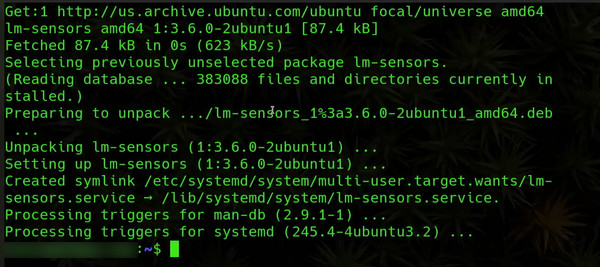
Next, you need to enter the commands sensors-detect and sensors on the Terminal. As you can see, the temperatures of all the cores are actively monitored and reported by the app.
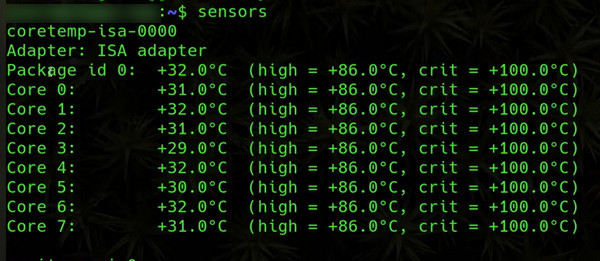
When you determine that the CPU is running hotter than normal, it is better to clean your PC.
3. Using Psensor
Psensor monitors the CPU temperature and reports back to you using a graphical interface. It is easier to use if you do not like fiddling around the Terminal.
These are the steps to check the CPU temperature using Psensor:
- Press Ctrl + Alt + T to bring up the Terminal.
- Type sudo apt install psensor. Enter your password if prompted by the system.
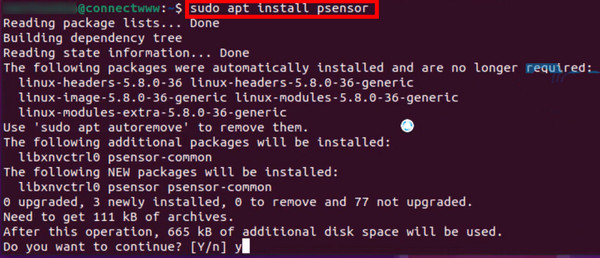
- Now type psensor to launch the app from the Terminal.
Now the app will be installed on your system. To monitor the temperature, type psensor. This will launch the application. You can also search for the app from the list of installed applications and open it from there.
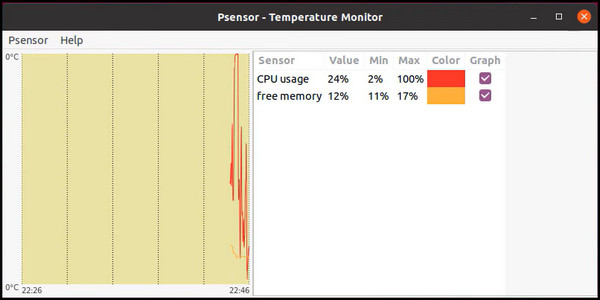
A graph will show you the CPU usage and the related temperatures. You can customize the Temperature units, such as Celcius/Fahrenheit, or change the app to start every time with the system.
If you have a GPU connected, you can also make the app measure its temperature too.
We explored if a CPUs high temperature affects your frame rates and causes lag during gaming. Do check it out.
4. Using HardInfo
HardInfo is an all-in-one hardware reporting and monitoring tool. If you have used HWiNFO on Windows, you will find some stark similarities here.
As usual, you can install it using the Terminal. You can either use the command line to access it or the graphical interface. I find the graphical interface better, as all the components are separated into different sections. Clicking on any one of them will show you detailed information.
Follow the steps to monitor the CPU temperature using HardInfo:
- Open the Terminal by pressing Ctrl + Alt + T at the same time.
- Type in sudo apt install hardinfo.

- Provide the administrator password if the system asks.
Now you can launch the app by typing in hardinfo in the Terminal. Head over to the Processor section, and here you will find the temperature listed there. In case you notice any sign of overheating, go through our guide to know how to lower CPU temps properly.
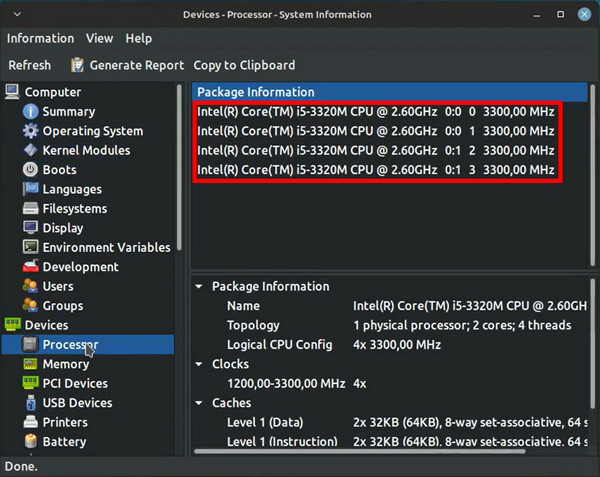
Conclusion
Many other applications can monitor the CPU’s temperature in Linux. Just search a forum, and people will tell you about all these different apps which they use. But I find Lm Sensors and Psensors the most convenient. They are easy to install and show the active temperatures right in the Terminal.
I hope this article helps you out in your quest to keep your PC cool.
With that said, it’s time for goodbye.




